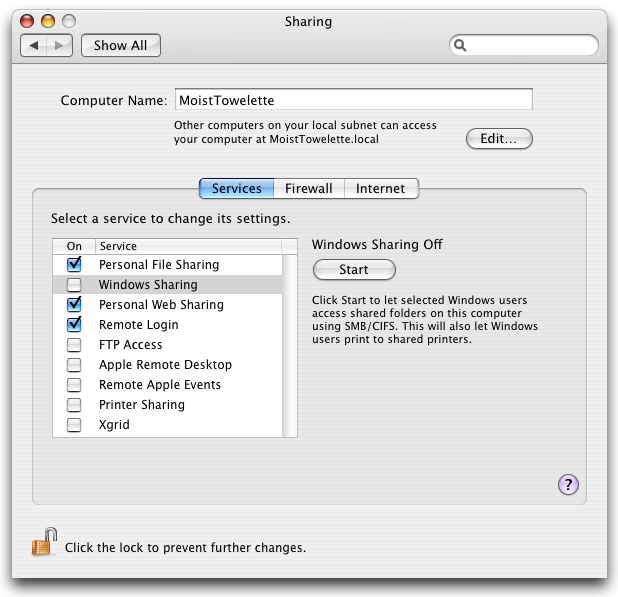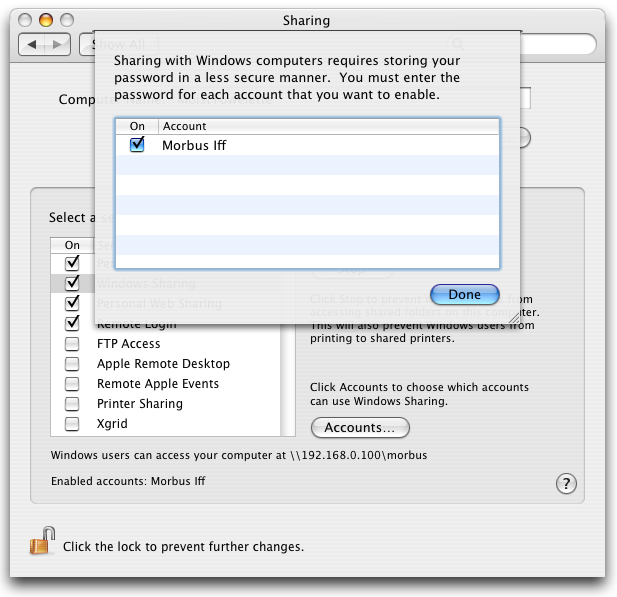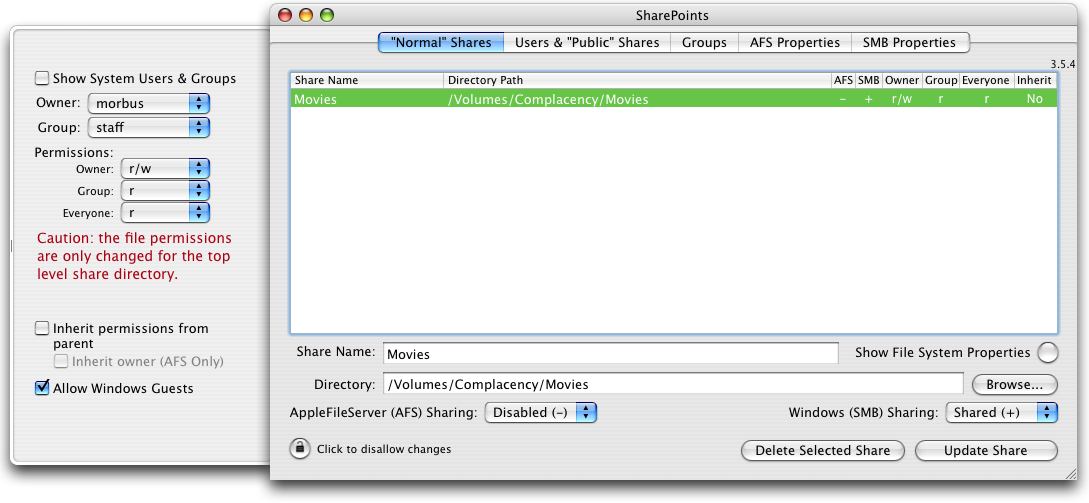[This has also been posted at MacDevCenter.com].
In response to Wireless Video Streaming from OS X to your TV?, fearless reader Scott noted the Mvix MX-760HD as offered by ThinkGeek. Out of all the possibilities posted, this seemed the most relevant: wireless, internal hard drive (which is entirely optional), USB connectivity, DivX and XviD playback, and composite video connectoids (along with others). After talking with Rich Knitter, MvixUSA's Director of Marketing, he agreed to send me a review unit with the hope that I also get step-by-step sharing instructions for (the as-yet-tested) OS X.
Welp, I gotta tell ya, I'm pretty happy with this little thing.
Hardware setup was easy - the unit comes with a stand (which seemed a little loose until I found the center sweet spot), USB and composite video cables, a driver CD (which you won't ever need), remote control (a block of plastic with a central keypad similar to, but not as good as, a TiVo), the requisite power cables, and a 5dBi antenna. While the unit does support HD and progressive scan and all those other high-falutin' feel-goods, you'll need to supply your own cables. For this review, I've only used composite video because that's all I (care to, at the moment) have.
I first tested without installing a hard drive (the not-included but provided Maxtor 300GB is one of a few sizes available if you order directly from MvixUSA.com) because my focus was wireless streaming - I wanted my bevy of disks upstairs to combine into one voltronic horde of video bliss. Thus, after a quick load screen (in which DivX was misspelt as "Dvix"), I hopped into the Setup menu and started tweaking the network options. The UI isn't ugly (see the online PDF manual for some examples), though it does seem a bit syrupy at times, but not enough to be annoying.
What was annoying is its sole support for WEP as a wireless encryption standard. I don't look forward to reconfiguring all my game consoles, laptops, and handhelds away from the WPA I had been using before. After tweaking my network (as provided by a D-Link DGL-4300), the MX-760HD connected to it just fine, without having to manually specify IPs, routers, DNS, etc.
That left me with just nailing down the actual file sharing. First (tested under 10.4.8), enable OS X's Samba server by clicking "Windows Sharing" under Apple Menu > System Preferences... > Sharing. OS X will force you to choose which user account can use Windows Sharing but this won't actually matter to the MX-760HD - it doesn't send authentication so we'll need to specifically customize our server to allow guests. We'll also want to tweak exactly what directories we're sharing, as opposed to the enabled user's entire Home directory (note: even if that is what you want, you'll still need to configure it as "guests ok", something you'll probably want to reconsider for security reasons).


There are two different ways to configure the Samba server: by editing the /etc/smb.conf manually or by using a helper application like the donationware SharePoints. SharePoints has an advantage because it will display the read/write permissions of the directories you're sharing: "everyone" must have "read" access for the files to be shared properly. Before we continue, you may want to disable the default "share the entire home directory" option under SharePoint's SMB Properties > Home Directories. This is entirely optional.
To share a directory of movies, make sure you're on the "Normal Shares" tab, create a "Share Name" and "Browse..." to the right Directory. You'll also want to set the "Windows (SMB) Sharing" dropdown to "Shared (+)". Finally, click the magical circle to the right of "Show File System Properties". This drawer will offers an "Allow Windows Guests", which we'll need to enable for anything we want the MX-760HD to access. Under "Permissions", make sure "Everyone" can "r" (read) the directory, otherwise it'll will appear empty when browsed (note: this WILL change the literal permissions on disk - it's not just a Samba thing). If you haven't protected your wireless network with encryption (even if it's simply WEP, as required here), I'd heartily suggest you do so now. You'll be asked for your OS X Administrator password to effect any changes you make here. Your final screen should look something like:

Head back over to the MX-760HD and have it "Refresh" its Movie file listing. Should everything go as smoothly as it did for me, they'll be a bit of a pause as it scans (and caches) the share, but your movie files should be displayed; anything not a recognized movie file is not shown. One of the things I continue to appreciate is the long file name listings: you can actually see more than six or eight characters, and pausing on any one title will scroll the rest of the title in place. I don't understand why they didn't use this same interface for the "Recent Items" screen, which is utterly useless in its current icon-based incarnation. Choose what you'd like to watch, and depending on the size of the video, it'll start streaming to you wirelessly in 10 to 30 seconds. Awesome.
Installation of the optional hard drive is also easy: no tools are required though I did have some troubles getting the single case screw back into place, and it took a few tries of concerted jiggling to align it just right. Once the hard drive is in and connected via USB 2.0 to your Mac, format it with Disk Utility as an "MS-DOS File System" and you'll be good to go. Mounting the MX-760HD's hard drive does require its power adapter which can cause a bit of frustration when it's entangled into the mass of cables behind your entertainment center. Having a laptop in the living room is one solution; a separate internal drive enclosure for drive swapping is another. MvixUSA recently reported that a firmware update will allow mounting over the network as a NAS/NDAS device, but no ETA on this support has been provided.
Of the 20 or so ancient but much-cherished Britney Spears music videos I threw at it, all showed signs of bad cropping - some had a healthy 20 to 30 pixel column missing from the left hand side. Modern day movie rips encoded at 16:9 receive this same chopping on the right side too. This is disheartening but my previous standby, a Philips DVP-642, also suffered the same problem. Digital video software really needs take these files, figure out what dimensions they are at runtime, then display them shrunk to fit into the TV screen with a surrounding border. Either that, or a Zoom Out (nearly everything has Zoom In, why not Out? Cheap solution!) Some folks have suggested this may be due to my use of composite cables, and I cheerful admit my ignorance and luddism.
Codec and playback support was strong: after testing the first few minutes of nearly 150 movies stored on the hard drive, only two or three gave the unit problems. QPEL support is missing, nor can the unit handle the MS-MPEG4v2 codec which all the DAP's MST3K videos are ripped as, though they admit this is a problem:
However, MS-MPEG4v2 is not without it's faults, the most obvious of which being that it is a proprietary codec that is no longer in development and is not likely to make its way into settop boxes or consumer electronics anytime soon. While technically a derivative of the MPEG-4 standard, MS-MPEG4v2 does not produce an ISO compliant video stream. What that means from a practical cross-platform standpoint is that when MPEG-4 capable DVD players do start becoming available (or the rumored MPEG-4 based HD-DVD spec), getting MS-MPEG4v2 files to play on them will be a non-trivial task necessitating at the very least transcoding to an ISO compliant codec and the quality loss associated.
There are no current plans to support these codecs in a future firmware upgrade.
I did not test the Photo or Music playing capabilities to any persnickety degree, but the smallest increment of time for image slideshows is three seconds, which turns into roughly six or seven if you're wirelessly streaming 2 MB digital camera files. It'd be nice if the unit could start caching and requesting early so that a more smoother and faster slideshow transition is possible. There does seem to be some issues with the "Recent Items" function in relation to photos or missing media or perhaps amount of media: after looking at roughly 50 images of a 500 image directory, I deleted that share leaving me with just movies to be watched. However, browsing through the media list to get to the "Setup" menu caused a freeze on the "Photo" item, which showed "Recent Items" that no longer exist. I don't know the cause, but it was about 90 seconds before I regained control. There doesn't appear to be any way to delete the "Recent Items" so, at the moment, I'm just avoiding that menu item entirely and used the "Setup" button on the remote. A day later, I am unable to reproduce this particular freeze.
Apparent "freezes" like this happened a little more often than I would like, and it always seemed related to the unit's rebuilding of a file list that I know has changed. After adding 100 GBs of movies to one directory, a new access to the hard drive (which I've coquettishly named "Innards") caused the unit to appear unresponsive for nearly six minutes, nearly two minutes after I gave up clicking the "Down" arrow to check to see if it was working. Another down arrow finally teased a response, but my original request, to browse the contents of Innards, never happened. Accessing it again gave the lickety-split response I was hoping for and, save for these initial first requests after file modifications, access to large directories continues without incident. With that said, I dare not throw my 22,000 track MP3 library at it anytime soon (nor would I ever, as my sole desire is video watching).
I was unable to test subtitle support heavily, but there do seem to be problems with .sub and .idx files. Though it claims support for them, a Mvix help document suggests converting them to .srt instead; I was unable to get the files I had working (nor did I try to convert them). Another .srt file loaded with no problems, but the subtitles were in Italian so I am unable to confirm if they matched up with the video properly. There is support for timeshifting the subtitles backwards or forwards, and you can also change their position on screen. Finally, the color of the lettering can be changed from the default white to some others, but the font has black borders which should prevent any one color from being washed out by the current scene.
While there are problems here and there with the UI, I'm quite happy to have the MX-760HD as a central part of my video entertainment: I no longer intend to burn DVD-Rs anymore, and the wireless support removes the need for any other moving parts. Hopefully, future firmware updates will hammer out the remaining bugs, but until then, I'm quite happy to route around them: the advantages and other qualities make this combination of hard drive, streaming, and video too powerful to ignore.
